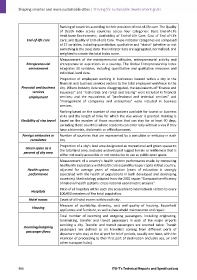Page 918 - Shaping smarter and more sustainable cities - Striving for sustainable development goals
P. 918
Ranking of countries according to their provision of end‐of‐life care. The Quality
of Death Index scores countries across four categories: Basic End‐of‐Life
Healthcare Environment; Availability of End‐of‐Life Care; Cost of End of‐Life
End‐of‐life care Care; and Quality of End‐of‐Life Care. These indicator categories are composed
of 27 variables, including quantitative, qualitative and "status" (whether or not
something is the case) data. The indicator data are aggregated, normalized, and
weighted to create the total index score.
Measurement of the entrepreneurial attitudes, entrepreneurial activity and
Entrepreneurial entrepreneurial aspirations in a country. The Global Entrepreneurship Index
environment integrates 31 variables, including quantitative and qualitative measures and
individual‐level data.
Proportion of employees working in businesses located within a city in the
financial and business services sectors to the total employed workforce in the
Financial and business city. Where industry data were disaggregated, the equivalents of "finance and
services insurance" and "real estate and rental and leasing" were included in financial
employment services; and the equivalents of "professional and technical services" and
"management of companies and enterprises" were included in business
services.
Ranking based on the number of visa waivers available for tourist or business
visits and the length of time for which the visa waiver is granted. Ranking is
Flexibility of visa travel based on the number of those countries that can stay for at least 90 days,
excluding those countries whose residents can enter only without a visa if they
have a biometric, diplomatic or official passport.
Foreign embassies or Number of countries that are represented by a consulate or embassy in each
consulates city.
Proportion of a city's land area designated as recreational and green spaces to
Green space as a the total land area. Excludes undeveloped rugged terrain or wilderness that is
percent of city area
either not easily accessible or not conducive to use as public open space.
Measurement of a country's health system performance made by comparing
healthy life expectancy with health care expenditures per capita in that country,
Health system adjusted for average years of education (years of education is strongly
performance associated with the health of populations in both developed and developing
countries). Methodology adapted from the 2001 report "Comparative efficiency
of national health systems: cross‐national econometric analysis".
Ratio of all hospitals within each city accessible to international visitors to every
Hospitals
100,000 members of the total population.
Hotel rooms Count of all hotel rooms within each city.
Measure of availability, diversity, cost and quality of housing, household
Housing
appliances and furniture, as well as household maintenance and repair.
Total number of incoming and outgoing passengers, including originating,
terminating, transfer and transit passengers in each of the major airports
servicing a city. Transfer and transit passengers are counted twice. Transit
Incoming/outgoing
passenger flows passengers are defined as air travellers coming from different ports of
departure who stay at the airport for brief periods, usually one hour, with the
intention of proceeding to their first port of destination (includes sea, air and
other transport hubs).
908 ITU‐T's Technical Reports and Specifications

